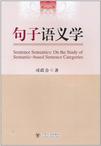句子语义学
出版时间:2010-12 出版社:东南大学出版社 作者:司联合 页数:412 字数:363000
内容概要
司联合博士的《句子语义学》提出了与还原主义方法不同的一种新的方法。司联合根据中国科学院声学研究所黄曾阳提出的概念层次网络(hierarchical network of concepts,HNC)理论,使用函数和演绎推理的方法来研究句子的语义。 司联合根据特征语义块描述作用效应链的环节的多少,来划分简单句(simple sentence)与繁复句(multiple sentence)。他指出:只描述一个环节的句子形成简单句,它们的类型称为基本句类,而描述两个以上的环节的句子就形成繁复句,句子中有两个以上的特征语义块的也可以形成繁复句。在繁复句的研究中,司联合采用了Leech的观点,把繁复句分为并列句、复合句和混合句,而混合句又可以进一步分为并列-复合句和复合-并列句。这样,就可以从语义角度,而不是语法角度,对句子的语义进行研究。
书籍目录
Preface序言Chapter OneIntroduction1.1Introduction1.2Lexica! Semantics and Word Meaning1.3Sentence Semantics1.3.1Situation Types1.3.2Tense1.3.3Aspect1.3.4Mood and Modality1.3.5Voice1.3.6Thematic Roles1.4Sentence Meaning1.4.1Word Meaning and Sentence Meaning1.4.2Sentence Meaning and Utterance Meaning and Propositional Meaning1.4.3Sentence Patterns, Sentence Types and Sentence Categories1.5Significance of the Book1.6Methodology and Corpus1.7Organization of the BookChapter TwoInterpretations of Sentence Meaning2.1Introduction2.2Katz' Semantic Theory2.3Montague Grammar2.4Leech's Semantic Structures of Sentences2.4.1Predications, Predicats, and Arguments2.4.2n-place Predicates2.4.3Predication Analysis2.4.4Subordinate Predication2.4.5Downgraded or 'Featurized' Predication2.5Logical Semantics on Sentence Meaning2.6Jackendoff's Conceptual Semantics2.7Huang's Hierarchical Network of Concepts (HNC)2.8The Theoretical Framework of Sentence Meaning2.8.1Theoretical Framework2.8.2Huang's Hypothesis of Semantic Chunks and Sentences2.8.3Si's Hypothesis of Sentence Meaning2.8.4Expressions of Semantic Chunks2.8.5Semantic Situation InformationChapter ThreePreliminaries3.1Introduction3.2Semantic Chunks (including E chunk and JKs)3.2.1Constituents of Chunks3.2.2Types of Semantic Chunks3.2.3Semantic Chunks and Phrases3.2.4Constiuents of Sentences3.2.5Seven Sentence Categories3.2.6Concept Knowledge3.2.7EChunk3.2.8JKs (juzi kuai)3.2.9How to Segment and Combine Chunks3.3Three Semantic Networks3.3.1Semantic Network of Primitive Concepts3.3.2Semantic Network of Basic Concepts3.3.3Semantic Network of Logical Concepts3.4Semantic Primitives3.5Semantic Structural Equation (SSE)3.6Linguistic and Philosophical Bases3.7ConceptsChapter FourSimple Sentences4.1Introduction4.2Action Sentences (XJs)4.2.1General Action Sentences4.2.2Beating Sentences4.2.3Reaction Sentences4.2.4Remitting Sentences4.2.5Binding Sentences4.3Process Sentences (PJs)4.3.1General Process Sentences4.3.2Basic Process Sentences4.3.3Sketch Sentences4.3.4Cause-effect & Effect-cause Sentences 4.4Transfer Sentences (TJs)4.4.1Introduction4.4.2General Transfer Sentences4.4.3Substance Transfer Sentences4.4.4Informational Transfer Sentences4.4.5General Incept Sentences4.4.6Pertinent Incept Sentences4.4.7Transmitting Sentences4.4.8Self-transfer Sentences4.4.9Exchange Sentences4.4.10Substitute Sentences and Transformational Sentences4.5Effect Sentences (YJs)4.5.1Introduction4.5.2General Effect Sentences4.5.3Basic Effect Sentences4.5.4Bi-objects Effect Sentences4.5.5Action-effect Sentences4.6Relation Sentences (RJs)4.6.1Introduction4.6.2Bi-directional Relation Sentences4.6.3Extended Bi-directional Relation Sentences4.6.4Basic Main and Subordinate Relation Sentences4.6.5Extended Main and Subordinate Relation Sentences4.7State Sentences (SJs)4.7.1Introduction4.7.2General State Sentences4.7.3Basic State Sentences4.7.4Bi-permutation State Sentences4.7.5Tri-permutation State Sentences4.7.6Concise State Sentences4.8Decision Sentences (DJs)4.8.1Introduction4.8.2General State Sentences4.8.3Chunk-extended Decision Sentences4.8.4Basic Decision Sentences4.8.5Comparative Decision Sentences4.8.6Concise Decision Sentences4.8.7Concise Situational Decision SentencesChapter FiveMultiple Sentences5.1Introduction5.2Compound Sentences5.3Complex Sentences5.4Mixed Sentences5.4.1Complex-Compound Sentences5.4.2Compound-complex Sentences5.5SummaryChapter Six Conclusions6.1Contributions and Implications of This Research6.2Some Issues Worthy of Further StudyBibliographyAppendix I: List of Nodes for Concepts in Semantic NetworksAppendix II: Expressions of Basic Sentence Categories
章节摘录
Speech act theory was developed by the Oxford philosopher J. L. Austin whose work was How to do Things with Words (1975). J. R. Searle has also made great contributions to speech acts. Austin proposed that communicating a speech act consists of three elements: the speaker says something, the speaker signals an associated speech act, and the speech act causes an effect on his listeners or the participants. He called the first element the locutionary act: the act of uttering a sentence with a certain meaning. The second element was called illocutionary act, a sentence is uttered to constitute an actof praise, criticism, agreement, etc. The third element was calledperlocutionary act: the speaker may have uttered the sentence he didutter to achieve a certain consequent response from his hearer —— suchas to frighten him, to amuse him, to get him to d something. Thedistinction between the illocutionary act and the perlocutionary act isimportant: the former is the consequent effect on the hearer which thespeaker intends should follow from his utterance, and such acts arenot normally regarded as relevant to a linguistic account of meaning,while the latter are not consequences of locutionary acts, but anintegral part of the utterance: it is what the speaker wanted hisutterance as. We can draw the three-fold distinction as follows: aspeaker utters sentences with a particular meaning (locutionary act),and with a particular force (illocutionary act), in order to achieve acertain effect on the hearer (perlocutionary act ).
图书封面
评论、评分、阅读与下载
用户评论 (总计1条)
- 该书有用
